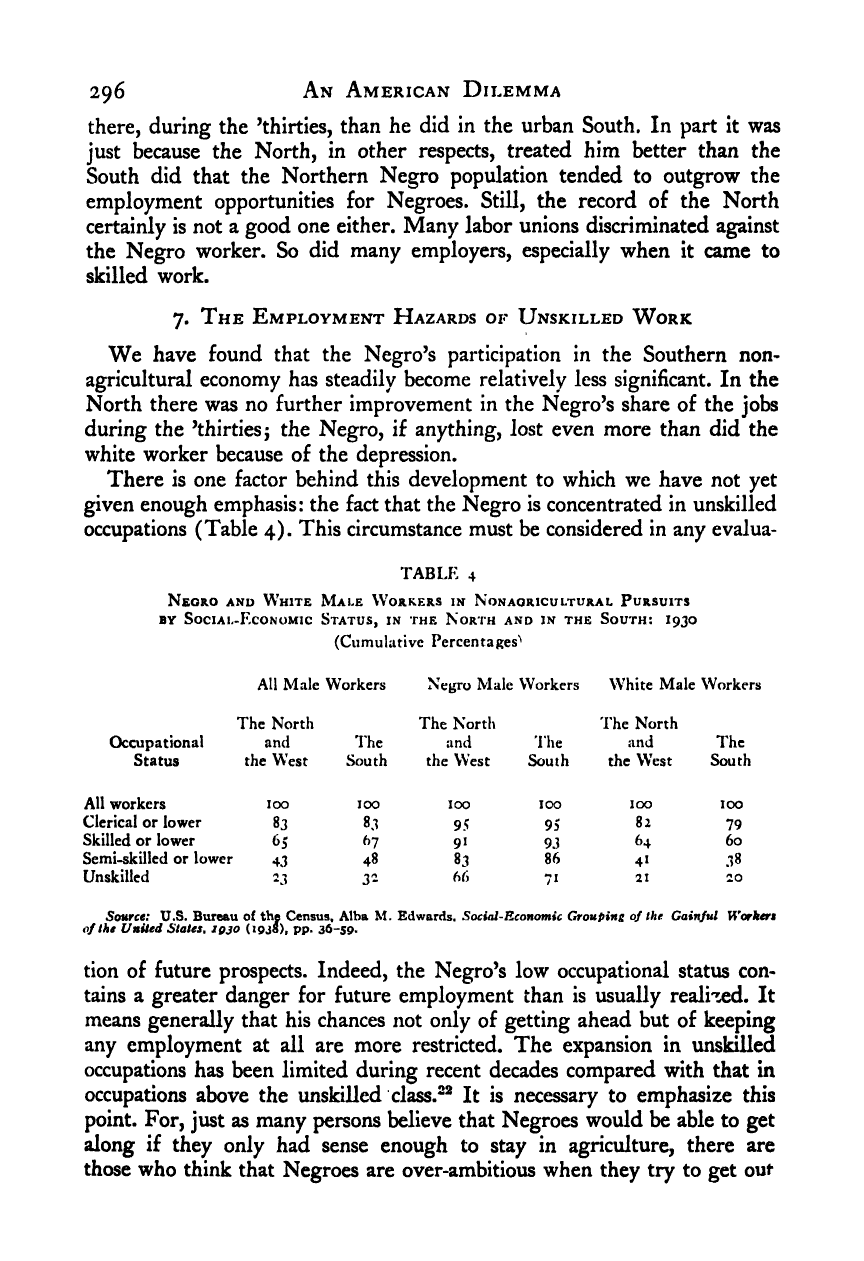Note: Gunnar Myrdal died in 1987, less than 70 years ago. Therefore, this work is protected by copyright, restricting your legal rights to reproduce it. However, you are welcome to view it on screen, as you do now. Read more about copyright.
Full resolution (TIFF) - On this page / på denna sida - IV. Economics - 13. Seeking Jobs Outside Agriculture - 6. A Closer View on Northern Trends - 7. The Employment Hazards of Unskilled Work

<< prev. page << föreg. sida << >> nästa sida >> next page >>
Below is the raw OCR text
from the above scanned image.
Do you see an error? Proofread the page now!
Här nedan syns maskintolkade texten från faksimilbilden ovan.
Ser du något fel? Korrekturläs sidan nu!
This page has never been proofread. / Denna sida har aldrig korrekturlästs.
296 An American Dilemma
there, during the ’thirties, than he did in the urban South. In part it was
just because the North, in other respects, treated him better than the
South did that the Northern Negro population tended to outgrow the
employment opportunities for Negroes. Still, the record of the North
certainly is not a good one either. Many labor unions discriminated against
the Negro worker. So did many employers, especially when it came to
skilled work.
7. The Employment Hazards of Unskilled Work
We have found that the Negro’s participation in the Southern non-
agricultural economy has steadily become relatively less significant. In the
North there was no further improvement in the Negro’s share of the jobs
during the ’thirties j
the Negro, if anything, lost even more than did the
white worker because of the depression.
There is one factor behind this development to which we have not yet
given enough emphasis: the fact that the Negro is concentrated in unskilled
occupations (Table 4). This circumstance must be considered in any evalua-
TABLE 4
Negro and White Male Workers in Nonaoricultural Pursuits
BY Sociai-Economic Status, in the North and in the South: 1930
(Cumulative Percentages’’
All Male Workers Negro Male Workers White Male Workers
The North The North The North
Occupational and The and I’he and The
Status the West South the West South the West South
All workers 100 100 100 100 100 100
Clerical or lower 83 83 95 95 82 79
Skilled or lower ^7 91 93 64 60
Semi-skilled or lower 43 48 83 86 41 38
Unskilled 23 32 66 71 21 20
Source: U.S. Bureau of the Census, Alba M. Edwards. Social-Economic Grouping of the Gainful Workert
of the United States, jqjo (i 9Jo)> PP* 36-59.
tion of future prospects. Indeed, the Negro’s low occupational status con-
tains a greater danger for future employment than is usually realized. It
means generally that his chances not only of getting ahead but of keeping
any employment at all are more restricted. The expansion in unskilled
occupations has been limited during recent decades compared with that in
occupations above the unskilled class.*^ It is necessary to emphasize this
point. For, just as many persons believe that Negroes would be able to get
along if they only had sense enough to stay in agriculture, there are
those who think that Negroes are over-ambitious when they try to get out
<< prev. page << föreg. sida << >> nästa sida >> next page >>